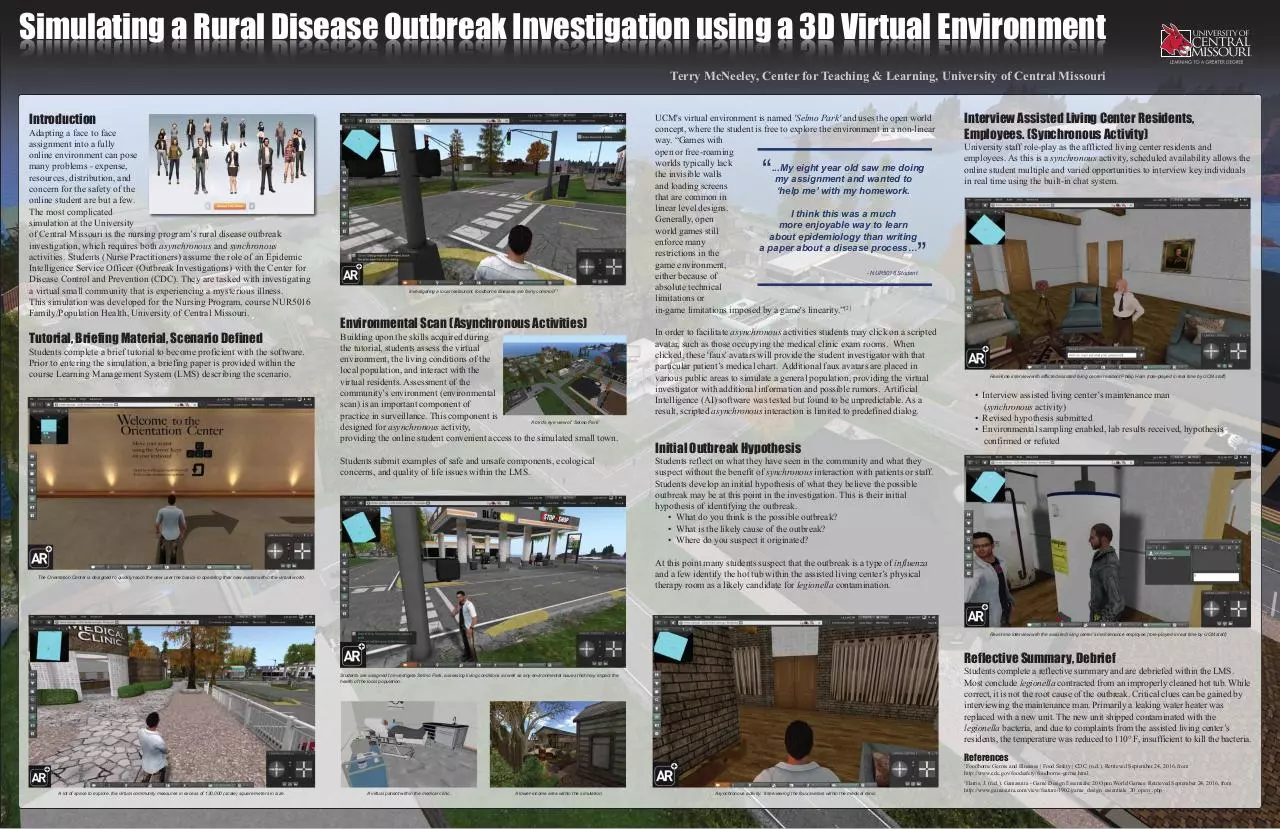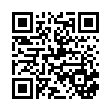2016 McNeeley (PDF)
File information
Title: NASAGA-2016-McNeeley
This PDF 1.5 document has been generated by Adobe Illustrator CS6 (Macintosh) / Adobe PDF library 10.01, and has been sent on pdf-archive.com on 25/10/2016 at 20:28, from IP address 153.91.x.x.
The current document download page has been viewed 1942 times.
File size: 1.01 MB (1 page).
Privacy: public file

File preview
Simulating a Rural Disease Outbreak Investigation using a 3D Virtual Environment
Terry McNeeley, Center for Teaching & Learning, University of Central Missouri
Introduction
Adapting a face to face
assignment into a fully
online environment can pose
many problems - expense,
resources, distribution, and
concern for the safety of the
online student are but a few.
The most complicated
simulation at the University
of Central Missouri is the nursing program’s rural disease outbreak
investigation, which requires both asynchronous and synchronous
activities. Students (Nurse Practitioners) assume the role of an Epidemic
Intelligence Service Officer (Outbreak Investigations) with the Center for
Disease Control and Prevention (CDC). They are tasked with investigating
a virtual small community that is experiencing a mysterious illness.
This simulation was developed for the Nursing Program, course NUR5016
Family/Population Health, University of Central Missouri.
Tutorial, Briefing Material, Scenario Defined
Students complete a brief tutorial to become proficient with the software.
Prior to entering the simulation, a briefing paper is provided within the
course Learning Management System (LMS) describing the scenario.
UCM's virtual environment is named 'Selmo Park' and uses the open world
concept, where the student is free to explore the environment in a non-linear
way. “Games with
open or free-roaming
worlds typically lack
...My eight year old saw me doing
the invisible walls
my assignment and wanted to
and loading screens
‘help me’ with my homework.
that are common in
linear level designs.
I think this was a much
Generally, open
more enjoyable way to learn
world games still
about epidemiology than writing
enforce many
a paper about a disease process…
restrictions in the
game environment,
- NUR5016 Student
either because of
absolute technical
limitations or
in-game limitations imposed by a game's linearity.”[2]
“
Interview Assisted Living Center Residents,
Employees. (Synchronous Activity)
University staff role-play as the afflicted living center residents and
employees. As this is a synchronous activity, scheduled availability allows the
online student multiple and varied opportunities to interview key individuals
in real time using the built-in chat system.
”
Investigating a local restaurant, foodborne illnesses are fairly common[1]
Environmental Scan (Asynchronous Activities)
Building upon the skills acquired during
the tutorial, students assess the virtual
environment, the living conditions of the
local population, and interact with the
virtual residents. Assessment of the
community’s environment (environmental
scan) is an important component of
practice in surveillance. This component is
A bird’s eye view of ‘Selmo Park’
designed for asynchronous activity,
providing the online student convenient access to the simulated small town.
In order to facilitate asynchronous activities students may click on a scripted
avatar, such as those occupying the medical clinic exam rooms. When
clicked, these 'faux' avatars will provide the student investigator with that
particular patient’s medical chart. Additional faux avatars are placed in
various public areas to simulate a general population, providing the virtual
investigator with additional information and possible rumors. Artificial
Intelligence (AI) software was tested but found to be unpredictable. As a
result, scripted asynchronous interaction is limited to predefined dialog.
Students submit examples of safe and unsafe components, ecological
concerns, and quality of life issues within the LMS.
Students reflect on what they have seen in the community and what they
suspect without the benefit of synchronous interaction with patients or staff.
Students develop an initial hypothesis of what they believe the possible
outbreak may be at this point in the investigation. This is their initial
hypothesis of identifying the outbreak.
• What do you think is the possible outbreak?
• What is the likely cause of the outbreak?
• Where do you suspect it originated?
Real-time interview with afflicted assisted living center resident Phillip Ham (role-played in real time by UCM staff)
• Interview assisted living center’s maintenance man
(synchronous activity)
• Revised hypothesis submitted
• Environmental sampling enabled, lab results received, hypothesis
confirmed or refuted
Initial Outbreak Hypothesis
At this point many students suspect that the outbreak is a type of influenza
and a few identify the hot tub within the assisted living center’s physical
therapy room as a likely candidate for legionella contamination.
The Orientation Center is designed to quickly teach the new user the basics in operating their new avatar within the virtual world.
Real-time interview with the assisted living center’s maintenance employee (role-played in real time by UCM staff)
Reflective Summary, Debrief
Students complete a reflective summary and are debriefed within the LMS.
Most conclude legionella contracted from an improperly cleaned hot tub. While
correct, it is not the root cause of the outbreak. Critical clues can be gained by
interviewing the maintenance man. Primarily a leaking water heater was
replaced with a new unit. The new unit shipped contaminated with the
legionella bacteria, and due to complaints from the assisted living center’s
residents, the temperature was reduced to 110° F, insufficient to kill the bacteria.
Students are assigned to investigate Selmo Park, assessing living conditions as well as any environmental issues that may impact the
health of the local population.
References
Foodborne Germs and Illnesses | Food Safety | CDC. (n.d.). Retrieved September 24, 2016, from
http://www.cdc.gov/foodsafety/foodborne-germs.html
1
Harris, J. (n.d.). Gamasutra - Game Design Essentials: 20 Open World Games. Retrieved September 24, 2016, from
http://www.gamasutra.com/view/feature/1902/game_design_essentials_20_open_.php
2
A lot of space to explore, the virtual community measures in excess of 130,000 (scale) square meters in size.
A virtual patient within the medical clinic.
A lower-income area within the simulation.
Asynchronous activity: ‘Interviewing’ the faux avatars within the medical clinic.
Download 2016-McNeeley
2016-McNeeley.pdf (PDF, 1.01 MB)
Download PDF
Share this file on social networks
Link to this page
Permanent link
Use the permanent link to the download page to share your document on Facebook, Twitter, LinkedIn, or directly with a contact by e-Mail, Messenger, Whatsapp, Line..
Short link
Use the short link to share your document on Twitter or by text message (SMS)
HTML Code
Copy the following HTML code to share your document on a Website or Blog
QR Code to this page

This file has been shared publicly by a user of PDF Archive.
Document ID: 0000499651.